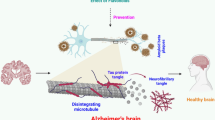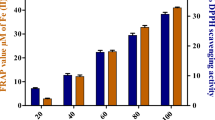Abstract
As superoxide (·O −2 ) and hydroxyl radical (·OH) have been implicated in pathogenesis of Parkinson’s disease, free radical scavenging, antioxidant, and neuroprotective agents have attracted attention as ways to prevent progression. We examined effects of zingerone, an alkaloid extracted from ginger root, on 6-hydroxydopamine (6-OHDA)-induced dopamine (DA) reduction in mouse striatum. Zingerone administration 1 h before and for 6 more days following one intracerebroventricular 6-OHDA injection prevented reductions of striatal DA and its metabolites, and increased serum ·O −2 scavenging activity. Zingerone did not change activities of catalase or glutathione peroxidase in striatum or serum, or ·O −2 scavenging activity in striatum. Treatment with diethyldithiocarbamate, SOD inhibitor, abolished the protective effect of zingerone against 6-OHDA-induced DA reduction. In vitro, zingerone scavenged ·O −2 and ·OH and suppressed lipid peroxidation only weakly. Thus, direct antioxidant effects may be a minor component of its putative neuroprotective effect; instead, zingerone acted mainly by increasing systemic superoxide dismutase activity. Effects of zingerone treatment in this model suggest possible value in treatment of Parkinson’s disease.
Similar content being viewed by others
References
R. J. Tolwani M. W. Jakowec G. M. Petzinger S. Green K. Waggie (1999) ArticleTitleExperimental models of Parkinson’s disease: insights from many models Lab. Anim. Sci 49 363–371 Occurrence Handle1:STN:280:DyaK1MvgvVGitQ%3D%3D Occurrence Handle10480640
R. Andrew D. G. Watson S. A. Best H. Midgey H. Wenlong R. K. H. Petty (1993) ArticleTitleThe determination of hydroxydopamines and other trace amines in the urine of Parkinsonian patients and normal controls Neurochem. Res 18 1175–1177 Occurrence Handle1:CAS:528:DyaK2cXitlequw%3D%3D Occurrence Handle8255370
T. Kondo (1996) ArticleTitleParkinson’s disease and free radicals. Mechanism of neurodegeneration and neuroprotection Ann. N.Y. Acad. Sci 786 206–216 Occurrence Handle1:CAS:528:DyaK28XkvFCmsrg%3D Occurrence Handle8687020
Y. Glinka M. Gassen M. B. H. Youdim (1997) ArticleTitleMechanism of 6-hydroxydopamine neurotoxicity J. Neural. Transm. Suppl 50 55–66 Occurrence Handle1:STN:280:ByiC1M7mvVI%3D Occurrence Handle9120425
R. Kumar A. K. Agarwal P. K. Seth (1995) ArticleTitleFree radical-generated neurotoxicity of 6-hydroxydopamine J. Neurochem 64 1703–1707 Occurrence Handle1:CAS:528:DyaK2MXksVKit74%3D Occurrence Handle7891098
Y. S. Kim W. S. Joo B. K. Jin Y. H. Cho H. H. Baik C. W. Park (1998) ArticleTitleMelatonin protects 6-OHDA-induced neuronal death of nigrostriatal dopaminergic system Neuroreport 9 2387–2390 Occurrence Handle1:CAS:528:DyaK1cXltVKltL4%3D Occurrence Handle9694233
J. L. Cadet M. Katz V. Jackson-Lewis S. Fahn (1989) ArticleTitleVitamin E attenuates the toxic effects of intrastriatal injection of 6-hydroxydopamine (6-OHDA) in rats: behavioral and biochemical evidence Brain Res 476 10–15 Occurrence Handle1:CAS:528:DyaL1MXlt1Gktw%3D%3D Occurrence Handle2492442
H. Kabuto I. Yokoi E. Iwata-Ichikawa N. Ogawa (1999) ArticleTitleEPC-K1, a hydroxyl radical scavenger, prevents 6-hydroxydopamine-induced dopamine depression in the mouse striatum by up-regulation of catalase activity Neurochem. Res 24 1543–1548 Occurrence Handle1:CAS:528:DyaK1MXnsFSjurg%3D Occurrence Handle10591404
A. C. Reddy B. R. Lokesh (1992) ArticleTitleStudies on spice principles as antioxidants in the inhibition of lipid peroxidation of rat liver microsomes Mol. Cell. Biochem 111 117–124 Occurrence Handle1:CAS:528:DyaK38Xkt1Cru7o%3D Occurrence Handle1588934
T. P. Krishnakantha B. R. Lokesh (1993) ArticleTitleScavenging of superoxide anions by spice principles Indian J. Biochem. Biophys 30 133–134 Occurrence Handle1:CAS:528:DyaK3sXmt1Gju78%3D Occurrence Handle8394839
H. Kabuto I. Yokoi N. Ogawa (1998) ArticleTitleMelatonin inhibits iron-induced epileptic discharges in rats by suppressing peroxidation Epilepsia 39 237–243 Occurrence Handle1:CAS:528:DyaK1cXitVGlsLY%3D Occurrence Handle9578039
H. Aebi (1984) ArticleTitleCatalase in vitro Methods Enzymol 105 121–126 Occurrence Handle1:CAS:528:DyaL2cXltVKis7s%3D Occurrence Handle6727660
O. J. Lowry N. J. Rosebrough A. L. Farr R. L. Randall (1951) ArticleTitleProtein measurement with folin-phenol reagent J. Biol. Chem 193 265–275 Occurrence Handle1:CAS:528:DyaG38XhsVyrsw%3D%3D Occurrence Handle14907713
K. Mitsuta Y. Mizuta M. Kohno M. Hiramatsu A. Mori (1990) ArticleTitleThe application of ESR spin-trapping technique to the evaluation of SOD-like activity of biological substances Bull. Chem. Soc. Jpn 63 187–191 Occurrence Handle1:CAS:528:DyaK3cXhsFCjtLs%3D
J. M. C. Gutteridge (1994) ArticleTitleHydroxyl radicals, iron, oxidative stress, and neurodegeneration Ann. N.Y. Acad. Sci 738 201–213 Occurrence Handle1:CAS:528:DyaK28XjvV2ksrw%3D Occurrence Handle7832429
D. T. Dexter F. R. Wells A. J. Lees Y. Agid P. Jenner C. D. Marsden (1989) ArticleTitleIncreased nigral iron content and alterations in other metal ions occurring in brain in Parkinson’s disease J. Neurochem 52 1830–1836 Occurrence Handle1:CAS:528:DyaL1MXkslGrs7k%3D Occurrence Handle2723638
L. M. Ambani M. H. Woert ParticleVan S. Murphy (1975) ArticleTitleBrain peroxidase and catalase in Parkinson disease Arch. Neurol 32 114–118 Occurrence Handle1:CAS:528:DyaE2MXht1aru7o%3D Occurrence Handle1122174
S. J. Kish C. Morito O. Hornykiewicz (1985) ArticleTitleGlutathione peroxidase activity in Parkinson’s diseases Neurosci. Lett 58 343–346 Occurrence Handle1:CAS:528:DyaL2MXlsFymsr0%3D Occurrence Handle4047494
P. Riederer E. Sofic W. D. Rausch B. Schmidt G. P. Reynolds K. Jellinger M. B. Youdim (1989) ArticleTitleTransition metals, ferritin, glutathione, and ascorbic acid in Parkinsonian brains J. Neurochem 52 515–520 Occurrence Handle1:CAS:528:DyaL1MXhtFals78%3D Occurrence Handle2911028
C. W. Olanow (1993) ArticleTitleA radical hypothesis for neurodegeneration Trends. Neurosci 16 439–444 Occurrence Handle7507613
R. J. Tolwani M. W. Jakowec G. M. Petzinger S. Green K. Waggie (1999) ArticleTitleExperimental models of Parkinson’s disease: insights from many models Lab. Anim. Sci 49 363–371 Occurrence Handle1:STN:280:DyaK1MvgvVGitQ%3D%3D Occurrence Handle10480640
B. Ferger S. Rose A. Jenner B. Halliwell P. Jenner (2001) ArticleTitle6-Hydroxydopamine increases hydroxyl free radical production and DNA damage in rat striatum Neuroreport 12 1155–1159 Occurrence Handle1:CAS:528:DC%2BD3MXjs1egu78%3D Occurrence Handle11338183
T. Kawada S. Sakabe T. Watanabe M. Yamamoto K. Iwai (1988) ArticleTitleSome pungent principles of spices cause the adrenal medulla to secrete catecholamine in anesthetized rats Proc. Soc. Exp. Biol. Med 188 229–233 Occurrence Handle3375268
M. Iida I. Miyazaki K. Tanaka H. Kabuto E. Iwata-Ichikawa N. Ogawa (1999) ArticleTitleDopamine D2 receptor-mediated antioxidant and neuroprotective effects of ropinirole, a dopamine agonist Brain Res 838 51–59 Occurrence Handle1:CAS:528:DyaK1MXlt1Shtrk%3D Occurrence Handle10446316
M. Barkats S. Millecamps A. Bilang-Bleuel J. Mallet (2002) ArticleTitleNeuronal transfer of the human Cu/Zn superoxide dismutase gene increases the resistance of dopaminergic neurons to 6-hydroxydopamine J. Neurochem 82 101–109 Occurrence Handle1:CAS:528:DC%2BD38XlsV2jsbg%3D Occurrence Handle12091470
M. Asanuma H. Hirata J. L. Cadet (1998) ArticleTitleAttenuation of 6-hydroxydopamine-induced dopaminergic nigrostriatal lesions in superoxide dismutase transgenic mice Neuroscience 85 907–917 Occurrence Handle1:CAS:528:DyaK1cXjt1Glsro%3D Occurrence Handle9639283
Author information
Authors and Affiliations
Corresponding author
Rights and permissions
About this article
Cite this article
Kabuto, H., Nishizawa, M., Tada, M. et al. Zingerone [4-(4-hydroxy-3-methoxyphenyl)-2-butanone] Prevents 6-Hydroxydopamine-induced Dopamine Depression in Mouse Striatum and Increases Superoxide Scavenging Activity in Serum. Neurochem Res 30, 325–332 (2005). https://doi.org/10.1007/s11064-005-2606-3
Accepted:
Issue Date:
DOI: https://doi.org/10.1007/s11064-005-2606-3




